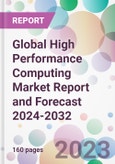According to the report, the global high performance computing market is projected to grow at a CAGR of 7.30% between 2024 and 2032. Aided by the escalating demand for complex data processing, intricate simulations, and the advancing sectors of artificial intelligence and machine learning, the market is expected to grow significantly by 2032.
High Performance Computing, often termed as supercomputing, involves the use of advanced systems to handle and process data at higher speeds than conventional computers. HPC systems are extensively deployed in tasks that demand vast amounts of data computation and simultaneous multitasking. These systems are quintessential in sectors such as scientific research, financial modelling, climate study, and any domain requiring high-speed data processing and output.
The escalating need for faster computing, especially in the domains of scientific research and predictive analysis, is a pivotal factor propelling the high performance computing market demand. As science and technology advance, the complexity of problems also increases, requiring sophisticated computing systems that can process data at unparalleled speeds.
Moreover, the swift rise in data analytics, artificial intelligence, and machine learning has further augmented the demand for HPC. Industries are leveraging these technologies for predictive insights, real-time analytics, and to derive patterns from vast datasets. As per the high performance computing market analysis, these tasks, being computationally intensive, naturally benefit from the capabilities of high performance computing.
Another significant driver is the burgeoning growth in the bioinformatics and genomics sectors. As researchers and scientists delve deeper into DNA sequencing and genetic algorithms, the need for faster computational abilities becomes paramount, thereby driving the high performance computing market growth.
The continuous developments in cloud-based HPC solutions also present vast opportunities for market expansion. With the cloud, businesses and researchers can access HPC capabilities without the need for colossal capital investments in infrastructure. This not only democratises access to HPC but also enables scalability, further increasing the value of the high performance computing market size.
High Performance Computing, often termed as supercomputing, involves the use of advanced systems to handle and process data at higher speeds than conventional computers. HPC systems are extensively deployed in tasks that demand vast amounts of data computation and simultaneous multitasking. These systems are quintessential in sectors such as scientific research, financial modelling, climate study, and any domain requiring high-speed data processing and output.
The escalating need for faster computing, especially in the domains of scientific research and predictive analysis, is a pivotal factor propelling the high performance computing market demand. As science and technology advance, the complexity of problems also increases, requiring sophisticated computing systems that can process data at unparalleled speeds.
Moreover, the swift rise in data analytics, artificial intelligence, and machine learning has further augmented the demand for HPC. Industries are leveraging these technologies for predictive insights, real-time analytics, and to derive patterns from vast datasets. As per the high performance computing market analysis, these tasks, being computationally intensive, naturally benefit from the capabilities of high performance computing.
Another significant driver is the burgeoning growth in the bioinformatics and genomics sectors. As researchers and scientists delve deeper into DNA sequencing and genetic algorithms, the need for faster computational abilities becomes paramount, thereby driving the high performance computing market growth.
The continuous developments in cloud-based HPC solutions also present vast opportunities for market expansion. With the cloud, businesses and researchers can access HPC capabilities without the need for colossal capital investments in infrastructure. This not only democratises access to HPC but also enables scalability, further increasing the value of the high performance computing market size.
Market Segmentation
The market can be divided based on component, deployment, organisation size, industry vertical, and region.Market Breakup by Component
- Solutions
- Servers
- Storage
- Networking Devices
- Software
- Services
- Design and Construction
- Integration and Deployment
- Training and Outsourcing
Market Breakup by Deployment
- On-Premises
- Cloud
Market Breakup by Organisation Size
- Small and Medium Enterprises
- Large Enterprises
Market Breakup by Industry Vertical
- BFSI
- Government and Defence
- Education and Research
- Manufacturing
- Media and Entertainment
- Healthcare and Life Sciences
- Energy and Utility
- Others
Market Breakup by Region
- North America
- Europe
- Asia Pacific
- Latin America
- Middle East and Africa
Competitive Landscape
The report looks into the market shares, plant turnarounds, capacities, investments, and mergers and acquisitions, among other major developments, of the leading companies operating in the global high performance computing market. Some of the major players explored in the report are as follows:- Hewlett Packard Enterprise Development LP
- Dell Inc
- Atos SE
- Microsoft Corporation
- NVIDIA Corporation
- IBM Corporation
- Intel Corporation
- Fujitsu Limited
- Cisco Systems, Inc.
- Lenovo Group
- Advanced Micro Devices, Inc
- NEC Corporation
- Others
Table of Contents
1 Preface2 Report Coverage - Key Segmentation and Scope4 Key Assumptions7 Opportunities and Challenges in the Market16 Key Trends and Developments in the Market
3 Report Description
5 Executive Summary
6 Market Snapshot
8 Global High Performance Computing Market Analysis
9 North America High Performance Computing Market Analysis
10 Europe High Performance Computing Market Analysis
11 Asia Pacific High Performance Computing Market Analysis
12 Latin America High Performance Computing Market Analysis
13 Middle East and Africa High Performance Computing Market Analysis
14 Market Dynamics
15 Competitive Landscape
List of Figures and Tables
Companies Mentioned
- Hewlett Packard Enterprise Development LP
- Dell Inc
- Atos SE
- Microsoft Corporation
- NVIDIA Corporation
- IBM Corporation
- Intel Corporation
- Fujitsu Limited
- Cisco Systems Inc.
- Lenovo Group
- Advanced Micro Devices Inc
- NEC Corporation
Methodology

LOADING...








